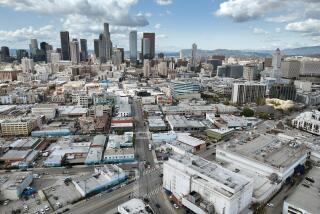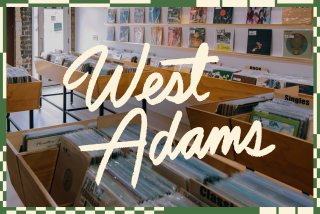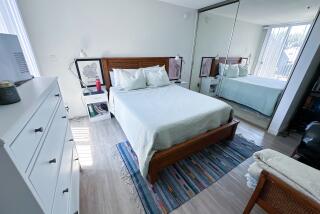From gritty to glamorous
When Laurel Canyon native Noah Stone went looking for a place to call his own last year, his thoughts first turned to Silver Lake and Atwater Village.
But then Stone, 35, remembered an ad he had seen in Dwell magazine about a new part of downtown near the corner of Industrial and Mateo streets, where a couple of old industrial buildings had been converted into lofts.
FOR THE RECORD:
Downtown development: An article in Saturday’s California section about L.A.’s downtown industrial district said the City Council imposed restrictions on residential development in industrial areas. Those restrictions were issued by the city Planning Department and redevelopment agency and supported by Mayor Antonio Villaraigosa. —
There, he found the Biscuit Company Lofts, a hulking building that was the former West Coast headquarters for Nabisco, which developers had restored into lofts.
While much attention has been focused on the downtown revival going on around the Staples Center, Walt Disney Concert Hall and the Old Bank District, a transformation of a different order is occurring to the east in L.A.’s gritty warehouse district.
Here, away from the bustling sidewalks and skyscrapers of the city center, narrow, quiet tree-lined streets intersected by old rail lines have become magnets for urban residents looking for a different downtown experience.
Low-slung cement and brick buildings house fashionable loft spaces, only a few hundred feet from their architectural cousins, many of which still function as the warehouses and manufacturing spaces for which they were originally intended. Birds chirp over the low rumbling of trucks. Residents say the area reminds them of New York’s TriBeCa or Chelsea districts when they were just becoming residential hot spots.
Stone, a singer-songwriter, likes the area because it is quiet enough for him to record music inside his loft -- but once he ventures outside, he said, he finds an almost instant community.
“You can’t get your mail without having five conversations,” he said.
Stone often starts his day getting milk at the gourmet market across the street, on the ground floor of the Toy Factory Lofts, and ends it at Royal Clayton’s restaurant a few doors down.
The area’s separation from the rest of downtown can be seen as its biggest asset or its biggest drawback. Some potential residents have bypassed the area, saying that it’s too far removed from public transportation and most of the retail services meant to support downtown dwellers -- and that surrounding streets are not made to handle pedestrian traffic.
Living next to operating factories and warehouses can also take some getting used to.
There has been much debate about how much of the downtown industrial area should be rezoned for residential purposes. While developers have been eager to convert old warehouses into lofts, critics argue that the trend is taking needed industrial jobs out of the city center. Earlier this year, the Los Angeles City Council placed strict limits on such conversions.
Still, the industrial zone east of downtown is booming. The area has lured several high-profile retailers from other posts downtown and in other parts of the city.
The Barker Block, a set of buildings that once housed the furniture company Barker Bros. and is now being converted into retail space and nearly 300 live-work units, will eventually house a half-dozen retailers as well as arts organizations including Arte Calidad and the Downtown Film Festival.
Sunset Plaza restaurant Caffe Primo is opening Primo Cucina, a gourmet restaurant and market that promises homemade pastas, gelato and a wood-burning oven for pizza. Organic coffee and tea company Urth Caffe is building a headquarters across from the Barker Block. The operation’s coffee roasting will move from Northern California; baking, tea-blending and administrative offices will relocate from other parts of downtown.
The move, admits Urth Caffe co-founder Shallom Berkman, is “risky.” But, he said, “We really wanted to be part of the rejuvenation process. . . . We love being part of grounded communities. And we jumped at the chance to develop a community from scratch.”
That’s a sentiment that seems to unite many of the retailers and residents who chose the area.
“We’ve gotten to know our neighbors,” said Cindy Rodriguez, who lives in a long, narrow unit in the Molino Street Lofts, in the shadow of the 4th Street Bridge. “It feels a little bit like New York. We’re years away from it, but you can feel the energy.”
Developer Paul Solomon, whose company Linear City developed both Biscuit Co. and Toy Factory lofts, said that in addition to the market and the restaurants on his block, “the other kind of business that works in an area that doesn’t have a lot of pedestrian traffic is one that can draw its own clientele, people who will travel specifically to go there.”
Clothing stores Secret Service and Apartment 3 have opened on the block, as well as an art gallery and a chocolatier. Restaurateur Steven Arroyo is opening Church & State in Biscuit this month, said Solomon.
Both Secret Service and Apartment 3, said Solomon, are not just stores but cultures -- places that both manufacture their products and highlight up-and-coming fashion designers.
Apartment 3 owner Kristin Knauff said that when her store left the La Brea area last year after 5 1/2 years, she knew it couldn’t rely on foot traffic. A sizable mailing list and frequent sample and trunk sales helped, she said. “We took a lot of our clients with us, and also got a new customer base, people from all of the loft buildings.”
Knauff said she still hears some trepidation from clients who haven’t ventured down to the area before. “There’s still a preconceived notion that the area isn’t developed,” she said. “But once they get down here, they’re psyched.”
Developers of the new lofts have tried to take some of the industrial edge off. Toy Factory has a rooftop pool and a garden terrace; Barker Block has a large grassy space in the middle of the block.
“We feel very safe and secure,” said Russell Roney, a real estate agent who moved into the Barker Block with his partner Bob Levinson last year. “We love the solitude, the quiet. . . . We might be a little ahead of the curve, but I think in five years this is going to be the hottest real estate in town. Simply because there is a vitality here you can feel, a youthful energy.”
Still, the quiet and isolation can cut both ways. Kathryn Hargreaves, who lives in a unit in the Molino Street Lofts and runs an art gallery, Dangerous Curve, out of the space next door, said the relative seclusion of the zone has been both a blessing and a curse. “We’re not in Chinatown or Culver City,” she said, “where collectors just walk in. It’s very hard on a gallery, where you are not in the middle of foot traffic.”
Hargreaves, who has lived in the area since 2002, said she was waiting for the arrival of more people drawn by more retail. For now, she’s taking stock of the new residents.
“All of a sudden, we have high end-cars parked around on our block.”
More to Read
Sign up for Essential California
The most important California stories and recommendations in your inbox every morning.
You may occasionally receive promotional content from the Los Angeles Times.










